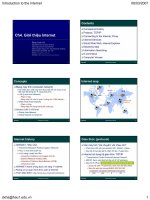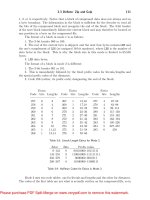A Gentle Introduction to the - Spring Framework
Bạn đang xem bản rút gọn của tài liệu. Xem và tải ngay bản đầy đủ của tài liệu tại đây (187.21 KB, 22 trang )
A Gentle Introduction to the
Spring Framework
T
he Spring Framework is an open source application framework written in Java, which supports
Java 1.3 and later. It makes building business applications with Java much easier compared with
using the classic Java frameworks and application programming interfaces (APIs), such as Java
Database Connectivity (JDBC) and JavaServer Pages (JSP). Since its introduction, the Spring Frame-
work has significantly improved the way people design and implement business applications by
incorporating best-practice methodologies and simplifying development.
As an introduction to the Spring Framework, this chapter will cover the following topics:
• The process of developing a typical business application and the role the Spring Framework
can play
• An overview of the modules that make up the Spring Framework
• An introduction to the sample application that you’ll be working with in this book
• An example that demonstrates one of the Spring Framework’s core features: managing
dependencies
• How the Spring Framework integrates with Java Enterprise Edition (Java EE)
• How to set up the Spring Framework in your applications
Building a Business Application
A modern business application typically consists of the following components:
• Relational database: Stores the data related to the problem domain. The database is not nec-
essarily part of the application, but the data-access classes have been written for the specific
schema of the database, so that the application is closely coupled with the database schema.
• Graphical user interface (GUI): Lets users interact with the business processes that are imple-
mented by the application. Since the days of the web revolution, many business applications
are web-based.
• Business logic: Controls and monitors the execution of business processes. The business
logic must work with the database and is called by the GUI.
Unfortunately, as tens of thousands of Java developers worldwide can testify, developing
business applications in Java can be very hard and frustrating. This is especially, although not exclu-
sively, true at the join points, where the business logic meets the database and the GUI meets the
business logic.
1
CHAPTER 1
9187ch01.qxd 8/2/07 10:05 AM Page 1
Java Platform Hurdles
Java is one of the most powerful and easy-to-use programming languages for developing business
applications, so it might seem strange to suggest that developing business applications in Java is
difficult. The main hurdles involve its extensive set of libraries and frameworks, each of which adds
a wide range of capabilities to Java.
The parts of the Java platform that are crucial for building typical business applications are as
follows:
• The JDBC API allows Java applications to connect to a wide range of relational databases.
• The Servlet and JSP specifications are crucial for web-based business applications.
• Desktop applications rely heavily on the Swing or Standard Widget Toolkit (SWT) APIs.
Each of these APIs offers useful capabilities for developing business applications, but most of
them are very difficult to use. For example, it’s hard to use the JDBC API correctly for very basic
queries on a database (see Chapter 5 for an example). JDBC is an intrusive API—it influences the
design of an application in such a way that the focus of the design shifts away from its original goals
toward trying to use the API in the application. In fact, because the JDBC API is so intrusive, appli-
cation developers should not spend their time trying to use it correctly. The same can be said for
many other APIs in the Java platform. This is where the Spring Framework steps in.
Enter the Spring Framework
A new open source application framework for Java was released on the first day of spring 2003. This
release was based on the source code introduced in Rod Johnson’s best-selling book, Expert One-
on-One J2EE Design and Development (Wrox, 2002).
This 1.0 release offered the building blocks for business application development. Common
tasks, such as connecting to and querying a database, managing transactions, and configuring
applications, were made more accessible and easier to accomplish. These building blocks used the
standard Java APIs behind the scenes and spared the developer from handling their complexity. The
1.1 and 1.2 releases consistently improved existing features and added new features and capabili-
ties. The most recent release (2.0) takes the efficiency of the Spring Framework one step further by
offering unparalleled improvements to ease of use and functionality.
The Spring Framework has started a revolution in the world of enterprise Java application
development and set in motion a series of events that have forever changed the way applications
are developed and deployed. A quick look at the modules that make up the framework should give
you an idea of its scope.
Introducing the Spring Framework Modules
The Spring Framework is a collection of subframeworks that solve specific problems and are
grouped together in modules. You are free to use any of these frameworks separately. Unless other-
wise mentioned, these modules are part of the Spring Framework distribution.
Inversion of Control (IoC) Container: Also called the Core Container, creates and configures
application objects and wires them together. This means that resources and collaborating
objects are provided to objects, so the objects do not need to look them up. This moves an
important responsibility out of your code and makes it easier to write and test code. Chapter 2
introduces the Core Container.
CHAPTER 1
■
A GENTLE INTRODUCTION TO THE SPRING FRAMEWORK2
9187ch01.qxd 8/2/07 10:05 AM Page 2
Aspect-Oriented Programming (AOP) framework: Works with cross-cutting concerns—one solu-
tion to a problem that’s used in multiple places. The Spring AOP framework links cross-cutting
concerns to the invocation of specific methods on specific objects (not classes) in such a way
that your code is unaware of their presence. The Spring Framework uses cross-cutting con-
cerns and AOP to let your application deal with transactions without having a single line of
transaction management code in your code base. AOP and cross-cutting concerns are covered
in Chapters 3 and 4.
Data Access framework: Hides the complexity of using persistence APIs such as JDBC,
Hibernate, and many others. Spring solves problems that have been haunting data-access
developers for years: how to get hold of a database connection, how to make sure that the con-
nection is closed, how to deal with exceptions, and how to do transaction management. When
using the Spring Framework, all these issues are taken care of by the framework. Chapters 5
and 6 cover data access with the Spring Framework.
Transaction Management framework: Provides a very efficient way to add transaction manage-
ment to your applications without affecting your code base. Adding transaction management
is a matter of configuration, and it makes the lives of application developers much easier.
Transaction management is quite a complex subject, and in Chapter 7, you’ll see how the
Spring Framework simplifies it dramatically.
Resource Abstraction framework: Offers a wonderful feature for conveniently locating files
when configuring your applications. Chapter 2 discusses resource abstraction.
Validation framework: Hides the details of validating objects in web applications or rich client
applications. It also deals with internationalization (i18n) and localization (l10n). Chapter 8
discusses validation.
Spring Web MVC: Provides a Model-View-Controller (MVC) framework that lets you build pow-
erful web applications with ease. It handles the mapping of requests to controllers and
of controllers to views. It has excellent form-handling and form-validation capabilities, and
integrates with all popular view technologies, including JSP, Velocity, FreeMarker, XSLT,
JasperReports, Excel, and PDFs. Chapters 8 and 9 cover the Spring Web MVC and the view
technologies.
Spring Web Flow: Makes implementing web-based wizards and complex workflow processes
very easy and straightforward. Spring Web Flow is a conversation-based MVC framework. Your
web applications will look much smarter once you learn how to use this framework. Spring
Web Flow is distributed separately and can be downloaded via the Spring Framework website.
Expert Spring MVC and Spring Web Flow (Apress, 2006) covers Spring Web Flow in detail.
Acegi Security System: Adds authentication and authorization to objects in your application
using AOP. Acegi can secure any web application, even those that do not use the Spring Frame-
work. It offers a wide range of authentication and authorization options that will fit your most
exotic security needs. Adding security checks to your application is straightforward and a
matter of configuration; you don’t need to write any code, except in some special use cases.
Acegi is distributed separately and can be downloaded from />downloads.html.
Remote Access framework: Adds client-server capabilities to applications through configura-
tion. Objects on the server can be exported as remotely available services. On the client, you
can call these services transparently, also through configuration. Remotely accessing services
over the network thus becomes very easy. Spring’s Remote Access framework supports HTTP-
based protocols and remote method invocation (RMI), and can access Enterprise JavaBeans as
a client. Pro Spring (Apress, 2005) covers Spring Remoting in detail.
CHAPTER 1
■
A GENTLE INTRODUCTION TO THE SPRING FRAMEWORK 3
9187ch01.qxd 8/2/07 10:05 AM Page 3
Spring Web Services: Takes the complexity out of web services and separates the concerns into
manageable units. Most web service frameworks generate web service end points and defini-
tions based on Java classes, which get you going really fast, but become very hard to manage as
your project evolves. To solve this problem, Spring Web Services takes a layered approach and
separates the transport from the actual web service implementation by looking at web services
as a messaging mechanism. Handling the XML message, executing business logic, and generat-
ing an XML response are all separate concerns that can be conveniently managed. Spring Web
Services is distributed separately and can be downloaded via the Spring Framework website
( />Spring JMX: Exports objects via Java Management Extensions (JMX) through configuration.
Spring JMX is closely related to Spring’s Remote Access framework. These objects can then be
managed via JMX clients to change the value of properties, execute methods, or report statis-
tics. JMX allows you to reconfigure application objects remotely and without needing to restart
the application.
Introducing the Sample Application
The sample application that comes with this book is a complex business application that tracks the
course of tennis tournaments and matches. The application consists of three modules that perform
the following functions:
Manage tennis tournaments and players: The application creates tournaments and players in
the database and handles player registration for tournaments. The application will automati-
cally place players in tournament pools based on their Association of Tennis Professionals
(ATP) ranking and will draw the matches for each pool. The application will also automatically
create a calendar for each court that’s available during the course of the tournament and man-
age the many other variables of a tournament.
Track the course of tennis matches played during tournaments: The application has a user inter-
face that records each point and error during the course of a tennis match. The application
knows when a set is over, who won it, and when the match is over. The business logic behind
this can be easily ported to mobile devices such as cell phones to conveniently track the course
of a match from the audience.
Report on historic data: Reports show the tournament history of individual players, the results
of individual matches and pools, the consistency of the tennis game of individual players, a
consistency comparison between players, and many other interesting pieces of data related to
tennis matches.
One of the core functions of the sample application is to track the course of a tennis match.
To better understand the domain of this application, you should have a basic understanding of the
game of tennis. Tennis has many rules and statistics, but for the sample application, we’ll keep the
basic rules for the game as follows:
• A player is either the server of a game or the receiver. The application will automatically
rotate the service when a game ends.
• A service that scores a point without the receiver being able to touch the ball is called an ace.
The number of aces scored by each player in the course of a match is an important statistic
to track.
CHAPTER 1
■
A GENTLE INTRODUCTION TO THE SPRING FRAMEWORK4
9187ch01.qxd 8/2/07 10:05 AM Page 4
• A server that makes an error during the service gets another chance. If the server fails at the
second attempt, the point goes to the receiver. The number of single and double service
errors is another important statistic.
• When the receiver handles the ball and returns the service, a rally begins. The point goes to
the player who can force the opponent to make an error. Some errors cannot be attributed
to any factor other than poor judgment by a player or lack of concentration and are called
unforced errors. This is another important statistic.
To summarize, the application needs to track the following statistics:
• Who scores each point
• The number of aces per player
• The number of single and double service errors per player
• The number of unforced errors per player
The application will use the scores to calculate when a game is over, when a set is over, and
when the match is over. The other statistics are stored for each player per each set.
The sample application is web-based and uses the Spring Framework throughout. Its imple-
mentation proves that the Spring Framework reduces the indirect costs of development projects by
providing solutions to common problems out of the box. In other words, you don’t have to reinvent
the wheel. This book will use code from the sample application to illustrate how to use the different
parts of the Spring Framework. By studying the implementation, you will be able to familiarize
yourself with the most efficient usage of the Spring Framework in typical business applications. The
sample application comes with extensive documentation that explains the design choices and the
usage of the Spring Framework. You can download the sample application and all the examples
used throughout the book from the Source Code/Download section of the Apress website
().
Now that you’ve seen the application we are going to build, let’s look at an important compo-
nent of application development—managing dependencies—and how the Spring Framework
removes a lot of the complexity.
Managing Dependencies in Applications
To demonstrate how the Spring Framework manages dependencies, let’s take a look at a use case
from the sample application that needs a data-access object that is configured to connect to the
database. We’ll see how a plain Java application deals with this situation and contrast this with how
Spring does it.
A Use Case That Has Dependencies
One of the requirements of the sample application is to start recording the course of a match during
a tournament. Before a tournament starts, all players who have registered are divided into pools,
depending on their ranking, age, and gender. For each pool, matches are created in the database.
If a pool consists of 32 players, 5 rounds are created: 16 matches in the sixteenth final, 8 matches in
the eighth final, 4 matches in the quarter final, 2 matches in the semifinal, and 1 final match. The
matches of the sixteenth final are drawn at the start of the tournament.
When any match in the pool is started, the application will check in the database for the follow-
ing information:
CHAPTER 1
■
A GENTLE INTRODUCTION TO THE SPRING FRAMEWORK 5
9187ch01.qxd 8/2/07 10:05 AM Page 5
• Whether the match exists
• If the match hasn’t finished yet
• If there are any previous matches
• If both previous matches have finished and who the winners are
Some matches are not played because one or both players don’t show up, give up before they
start, or are injured.
The TournamentMatchManager interface has a startMatch() method that takes the identifier of
the match to start, as shown in Listing 1-1.
Listing 1-1. The TournamentMatchManager Interface
package com.apress.springbook.chapter01;
public interface TournamentMatchManager {
Match startMatch(long matchId) throws
UnknownMatchException,
MatchIsFinishedException,
PreviousMatchesNotFinishedException,
MatchCannotBePlayedException;
}
This interface defines the contract of TournamentMatchManager. Classes that implement this
interface must go through all the steps in the process of starting a tennis match, as shown in
Listing 1-2.
Listing 1-2. The DefaultTournamentMatchManager Class,Which Implements
TournamentMatchManager
package com.apress.springbook.chapter01;
public class DefaultTournamentMatchManager implements
TournamentMatchManager {
private MatchDao matchDao;
public void setMatchDao(MatchDao matchDao) {
this.matchDao = matchDao;
}
protected void verifyMatchExists(long matchId) throws
UnknownMatchException {
if (!this.matchDao.doesMatchExist(matchId)) {
throw new UnknownMatchException();
}
}
protected void verifyMatchIsNotFinished(long matchId) throws
MatchIsFinishedException {
if (this.matchDao.isMatchFinished(matchId)) {
throw new MatchIsFinishedException();
}
}
/* other methods omitted for brevity */
CHAPTER 1
■
A GENTLE INTRODUCTION TO THE SPRING FRAMEWORK6
9187ch01.qxd 8/2/07 10:05 AM Page 6
public Match startMatch(long matchId) throws
UnknownMatchException, MatchIsFinishedException,
PreviousMatchesNotFinishedException, MatchCannotBePlayedException {
verifyMatchExists(matchId);
verifyMatchIsNotFinished(matchId);
Players players = null;
if (doesMatchDependOnPreviousMatches(matchId)) {
players = findWinnersFromPreviousMatchesElseHandle(matchId);
} else {
players = findPlayersForMatch(matchId);
}
return new Match(players.getPlayer1(), players.getPlayer2());
}
}
Let’s walk through what the startMatch() method in Listing 1-2 does:
1. The database is checked for a match with the given identifier (verifyMatchExists()).
2. The database is queried to verify that the match hasn’t been played already
(verifyMatchIsNotFinished()).
3. The database is queried again to check if the match that is about to start depends on the
outcome of two previous matches (doesMatchDependOnPreviousMatches()).
• If the match depends on previous matches, the winners are loaded from the database
(findWinnersFromPreviousMatchesElseHandle()) if those matches have ended. If one or
both previous matches have not been played, the match is not started and is marked in
the database as over.
• If the match is played in the first round of the tournament, the players who are drawn to
play this match are loaded from the database (findPlayersForMatch()).
4. When two players have been found and no exceptions have occurred, a Match object is
returned to the caller. The Match object is used to track the course of this game, and when
the match is over, the statistics are saved to the database.
The startMatch() method needs an implementation of the MatchDao interface that defines
the contract for working with the database. Implementation classes of the MatchDao interface are
responsible for informing the business logic about the current state of the match information in the
database. This information is vital to let the business process work correctly. (We use an interface
here to loosely couple the business logic to the data-access code, as explained in later sections.) The
MatchDao interface is shown in Listing 1-3.
Listing 1-3. The MatchDao Interface That’s Responsible for Querying the Database
package com.apress.springbook.chapter01;
public interface MatchDao {
boolean doesMatchExist(long matchId);
boolean isMatchFinished(long matchId);
boolean isMatchDependantOnPreviousMatches(long matchId);
boolean arePreviousMatchesFinished(long matchId);
Player findWinnerFromFirstPreviousMatch(long matchId);
CHAPTER 1
■
A GENTLE INTRODUCTION TO THE SPRING FRAMEWORK 7
9187ch01.qxd 8/2/07 10:05 AM Page 7
Player findWinnerFromSecondPreviousMatch(long matchId);
void cancelMatchWithWinner(long matchId, Player player, String comment);
void cancelMatchNoWinner(long matchId, String comment);
Player findFirstPlayerForMatch(long matchId);
Player findSecondPlayerForMatch(long matchId);
}
If you look at the course of a tournament as a workflow, you’ll see that there’s a start and an
end. The methods that return Boolean values in Listing 1-3 provide the business logic with informa-
tion about the current state of the tournament.
The methods that return Player objects use the information in the database to determine who
won previous matches. The cancelMatchWithWinner() and cancelMatchNoWinner() methods update
the state of the matches in the database.
Classes that implement the MatchDao interface need a connection to the database. For this pur-
pose, a data source is used (the javax.sql.DataSource interface) that creates a connection to the
database on demand. Data sources are discussed in more detail in Chapter 5; for now, you only
need to know that the javax.sql.DataSource interface is used to create connections to the database.
Let’s round up the dependencies in this use case. DefaultTournamentMatchManager objects
need a collaborating object that implements the MatchDao interface to access the database. For
the remainder of this chapter, we’ll use the JdbcMatchDao class as an implementation class. The
JdbcMatchDao class has a dependency on the javax.sql.DataSource interface, as shown in Listing 1-4.
JdbcMatchDao objects need a DataSource object to get a connection to the database.
Listing 1-4. JdbcMatchDao,Which Implements the MatchDao Interface and Queries the Database
package com.apress.springbook.chapter01.jdbc;
import javax.sql.DataSource;
import com.apress.springbook.chapter01.MatchDao;
import org.springframework.jdbc.core.JdbcTemplate;
public class JdbcMatchDao implements MatchDao {
private JdbcTemplate jdbcTemplate;
public void setDataSource(DataSource dataSource) {
this.jdbcTemplate = new JdbcTemplate(dataSource);
}
public boolean doesMatchExist(long matchId) {
return 1 == jdbcTemplate.queryForInt(
"SELECT COUNT(0) FROM T_MATCHES WHERE MATCH_ID = ?",
new Object[] { new Long(matchId) }
);
}
/* other methods omitted for brevity */
}
CHAPTER 1
■
A GENTLE INTRODUCTION TO THE SPRING FRAMEWORK8
9187ch01.qxd 8/2/07 10:05 AM Page 8









